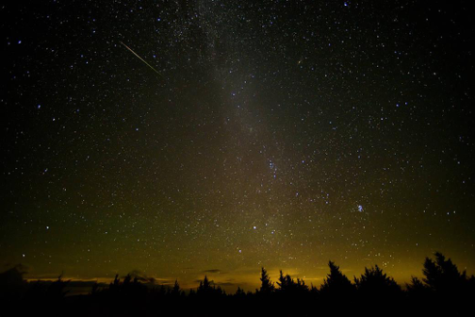Meteor shower visible this weekend
May 4, 2018

Most children hope a wish on a shooting star will make their dreams come true, but there isn’t much magic behind them.
Shooting stars are bits of space debris, like parts of asteroids, that hit earth’s atmosphere at high speeds. When these extremely fast moving particles hit the atmosphere, they become meteors and create friction with the air particles. The Eta Aquarids meteor shower will soon be visible over Hershey.
According to NASA, the friction creates heat which usually destroys the particles before they reach earth’s surface, but if the meteor does reach Earth’s surface it is then called a meteorite.
One predictable meteor shower is the Eta Aquarids in early May. “Named after their apparent “radiant” point in the constellation Aquarius, near one of its brightest stars, Eta Aquarii … the Eta Aquarids are one of two annual showers caused by Halley’s Comet (the other shower is the Perseids),” according to Space.
Although some shooting stars are random, there are predictable “meteor showers”. Meteor showers differ from regular meteors because they “occur when the Earth plows into the trail of particles left behind by a comet or asteroid,” according to Space.
Meteor showers can differ from year to year “depending on where the trail of particles falls in a particular year.” In fact, new meteor showers can occur or disappear depending on the trail of a comet or asteroid debris. These showers “are given names based on the constellation present in the sky from which they appear to originate,” although meteors do not actually originate from these stars, according to NASA.
Halley’s Comet, discovered in 239 BC by Chinese astronomers, is a periodic comet. Although it only crosses earth’s orbit in two places every 75 years, leftover debris strays from its comet’s path into earth’s path creating the annual meteor showers, called the Perseids. Among other things, radiation, pressure, interplanetary gas, and gravity can push these meteors off their original path.
This year, the Eta Aquarids shower will be visible from earth starting in late April and going until mid May. According to Bill Cooke, leader of NASA’s Meteoroid Environment Office, the peak of the shower should happen before dawn on May 7, 2018. There will be between 15 and 20 meteors per hour at its’ peak, though they may be washed out by moonlight.
Depending on where a person lives, the view of the shower will differ. For people in the Northern latitudes, a dark site with a clear view of the Southern horizon will be best. The closer a person is to the equator, the better the view will be, “even as far north as Miami, the view will be much better than it will be from New York or San Francisco.” In the Southern Hemisphere, a dark site with a clear view of the Northern horizon will give the best view of the meteor shower.
Although the meteors originate from Eta Aquarii, only watching the radiant point will cause people to “miss the meteors that create the longest bright streaks across the sky,” according to Cooke. Instead, a person should lay flat on their back and look at the sky, this gives the widest view.
Despite the fact that the Eta Aquarids don’t produce as many meteors per hour as the other Halley’s comet meteor shower, the meteors it does produce are just as bright if not brighter than the Perseids.
Even though some meteors do hit the ground, there is no chance of a meteor from these showers doing any damage. NASA said, “that’s because they are too small and move too fast to endure the plunge through Earth’s atmosphere; the heat generated from the friction with the atmosphere obliterates the little pieces of space rock.” So you can watch these spectacular solar events without fear of a space rock hitting you in the head.






